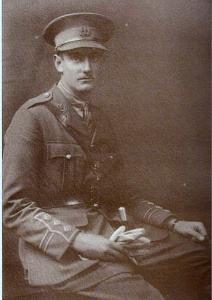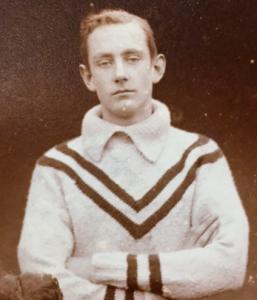
|

|
| Captain George Henry HESLOP | |
|
D Company, 16th (Service) Battalion Middlesex Regiment (Public Schools) Date of birth: 10th April 1895 Date of death: 1st July 1916 Killed in action aged 21 Buried at Hawthorn Ridge Cemetery No. 1 Auchonvillers Row B Grave 40 |

|
| George Henry Heslop was born at The School House, Sandbach in Cheshire con the 10th of April 1895 the son of George Henry Heslop MA, Headmaster of Sevenoaks School, and Gertrude Mary (nee Smith) Heslop later of 41, The Park, Mitcham in Surrey. He was educated at Lancing College where he was in Olds House from September 1910 to July 1914. He was a member of the Officer Training Corps where he achieved Certificate A. He was in the Cricket XI from 1911 to 1914 being Captain in 1913 and 1914. He topped the batting average in all his summer terms, scoring 981 runs in his time at Lancing, finishing the 1914 season with an average of 89. In 1913 he scored 148 runs in a first wicket stand of 238 with G.E. Palmer (Fields) against Hurstpierpoint. In 1914 he scored 223 against Steyning, 158 not out against the MCC, 157 against Eton Ramblers, and 151 against S. C. Bostock's XI. He also bowled, taking nine wickets for fourteen runs against Eastbourne College in 1913 and finishing the years 1913 and 1914 as the schools highest wicket taker also being second in the bowling averages for both years. He was described by Wisden as being "the most promising young all rounder who had yet to appear in a first class match". He was a member of the Football XI from 1911 to 1914 and was Captain from 1912 to 1914. He was appointed as a Prefect in 1913, won his sports colours in 1912, 1913 and 1914 and was Victor Ludorum in 1914. He won a place at Trinity College Cambridge in 1914 but did not take it, due to the outbreak of war, choosing to join the army instead. On the 11th of September 1914 he enlisted at 24 St James Street, London as Private 433 in the Public Schools Battalion of the Middlesex Regiment. He underwent a medical examination the same day where it was recorded that he was six feet two inches tall, weighed eleven stones eight pounds and that he had dark blue eyes and fair hair. He was passed fit for general service. He was commissioned as a 2nd Lieutenant in the 16th Battalion Middlesex Regiment on the 29th of September 1914, was promoted to Lieutenant on the 25th of January 1915 and to Captain on the 17th of May 1915. He attended Staff College for a month and qualified as a first class instructor of musketry. November 1915 found him at the front where he saw action at the Hohenzollern Redoubt. On the 26th of January 1916 the Germans attacked across the old Loos battlefield and the 16th Middlesex were called upon to re-enter the front line (they had been resting) to support a battalion of the King's Royal Rifle Corps. On the morning of the 28th of January the Company Commander of B Company, Major Way, was moving along the front line trench with Captain Sholto-Douglas and the company runner. Shortly behind them was George Heslop leading a group of men of roughly platoon strength. Suddenly a heavy barrage fell on the group killing the two officers, along with two other ranks, and wounding Heslop and fifteen other ranks. His father received the following telegram:- "Regret to inform you Capt G.H. Heslop 16th Middlesex wounded 28 January. Details wired when received." He returned to his unit shortly afterwards when he spent much time involved in the reorganisation of his battalion after the losses they had suffered during the fighting at Loos. He was put forward for promotion to Major but this was turned down on the grounds of his age and of insufficient experience. He attended a number of courses in bombing and machine gun practice and was appointed to the Staff at his Headquarters. He took part in a number of raids in the three weeks before the opening of the British offensive on the Somme on the 1st of July 1916. His Chaplain wrote of his attendance at Holy Eucharist shortly before the attack. In the early hours of the 1st of July 1916 the 16th Battalion Middlesex Regiment moved up from where they had been resting at Auchonvillers to assembly positions from where they would take their part in the opening attack. They were to join the rest of their Brigade in assaulting the German positions from the village of Beaumont Hamel to a position 100 yards to the west of the German trenches at the Hawthorn Redoubt. The Middlesex were to be in support of the 1st Battalion Lancashire Fusiliers and the attack would be immediately preceded by the explosion of a large mine under the Hawthorn Redoubt which would be the signal for the British advance to begin. D Company, led by Captain George Heslop, would be on the left of the battalions advance and would take a Stokes Mortar with them. They reached their assembly positions by 3am and by 6.25am the British artillery had become intense as zero hour approached. At 7.20am the mine under the Hawthorn Ridge exploded and at 7.30am the British advance began. The Middlesex followed at 7.55am, D Company quickly formed up into ranks, described as "parade ground straight", and began moving forward. As they crossed no man's land their ranks were swept by intense machine gun fire and men began to fall immediately. German artillery also joined the retaliation and began falling on the front line and support trenches adding to the enormous casualties. The attack quickly faded under the weight of enemy fire, with the few survivors going to ground to seek cover. Most, including George Heslop, had died in the two hundred yards between the British front line and the edge of the Hawthorn crater. By the end of the day the battalion had suffered 3 officers killed, 10 wounded, 5 missing with 6 more officers missing believed killed. Among the other ranks 19 were killed, 306 were wounded, 37 were missing believed killed and a further 138 were missing. His father received the following telegram dated the 6th of July 1916:- "Deeply regret to inform you that Captain G.H. Heslop Middlesex Regiment was reported missing believed killed on 1st July. The Army Council expresses their sympathy." One of his men wrote that he advanced that day "not minding the shells and bullets, but just leading us on as if nothing was happening." His Colonel wrote of the love felt for him in the regiment, of his rapid promotion and that of the 24 officer casualties on the 1st of July and that "no one's death would be more deeply felt." In a letter dated the 13th of September 1916 his father wrote to a Sevenoaks parent:- "My boy was killed on the 1st of July in the first ten minutes of the great push. There is nothing to say. He had a duty to do and it was done." On October 28th 1916 the following appeared in the Sussex Daily News:- "In memory of Captain G.H. Heslop, Middlesex Regiment, who fell in action last July, and who was very prominent in athletics at Lancing College, an anonymous gift has been provided, by means of which a cricket bat will be presented annually for the best individual performance in the Brighton College match." The first recipient of the bat was Maurice Cyril Philpot Tuckett (Heads 1912 to 1916) in 1916. In order to establish what had happened to George Heslop a number of statements were taken from members of his battalion who were present that day. On the 8th of August a statement was taken from Lance Corporal 2361 C Barnes, 16th Middlesex, while he was at 4th London General Hospital in Denmark Hill:- "Informant states "I had a letter from Pte. R.J. Hargreaves, who is in Ward 1, Southwood V.A.D. Hospital, Bickley, Kent, telling me that Capt. Heslop was killed"." On the 25th of October 1916 a statement was taken from Sergeant 1217 H.G. Valentine while he was in No. 11 General Hospital at Etaples. Valentine had been with the battalion signalling section that day:- "I started out with the Colonel, but got separated from him and found myself with Captain Heslop who was in charge of the Pioneers. By his order, we lay down by the wire and advanced about 100 yards. Then we saw him drop down. At first we thought he was giving the signal to halt, but as he lay still, we concluded that he was dead and continued on, leaving him there. Later we retired and reported to the Colonel. Search parties were sent out, but could find no trace of him." Another statement was taken from Private 1535 W.S.W Newshomle of B Company while he was in the 1st Eastern General Hospital Cambridge in November 1916:- "Informant states that Lt Featherstone, 16th Middlesex Regt. told him that Capt. Heslop was killed." A statement from Sergeant 1443 A. Butler, D Company was taken while he was at 5 Southern General Hospital, Faucett Road, Portsmouth:- "Informant states that on July or July 2nd at Beaumont Hill Capt. Heslop was seen lying dead just outside our parapet by L/Cpl Sephin, who told informant that he had examined Capt Heslop and had found him to be dead. Informant was lying out wounded for three days in this part of the line and said that the Germans were picking up and taking in many of our wounded, but as he was told that Capt. Heslop was lying nearer to our parapet than that of the Germans he did not think it likely that they had taken him in." Further enquiries included writing to the American Embassy, but with no result and on the 12th of March 1917 the War Office, having reviewed the evidence, concluded its investigations with a covering letter ending with the words:- "In view of this report and of the lapse of time since he was reported missing, the death of the above named officer has now been accepted for official purposes as having occurred "in action on the 1st of July 1916" ." His body was later recovered, identified and buried in 1917. His father applied for his medals in June 1922. He is commemorated on the war memorial at Sevenoaks School, on the memorial in the chapel at Trinity College Cambridge, on the memorial at Sevenoaks and on a plaque in St Nicholas' Church, Sevenoaks. |
|
 | |
| Olds House |
Back